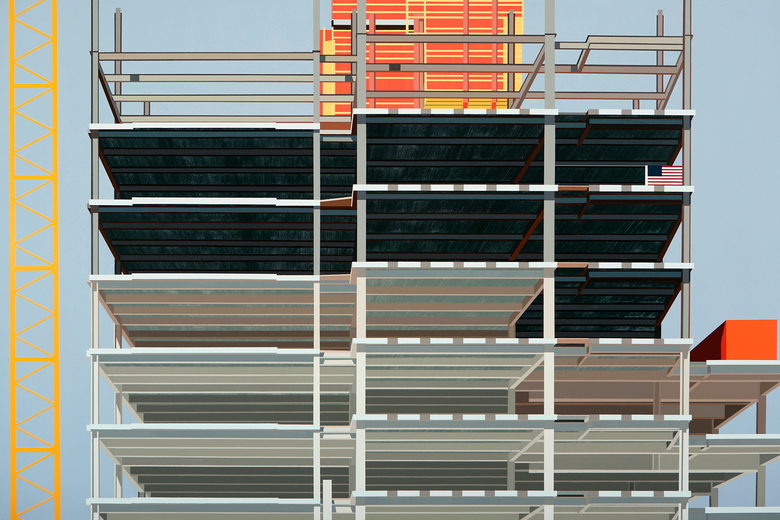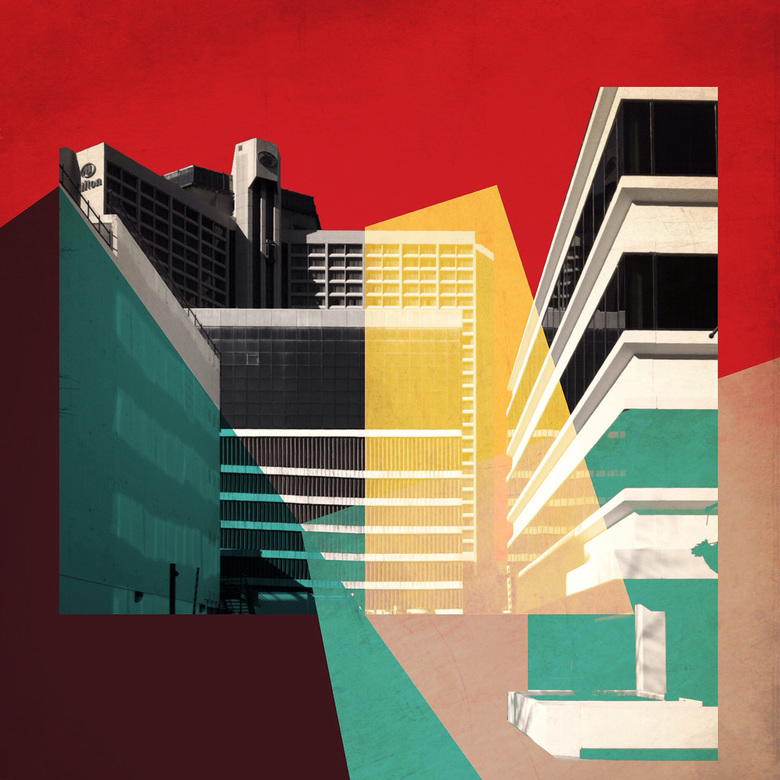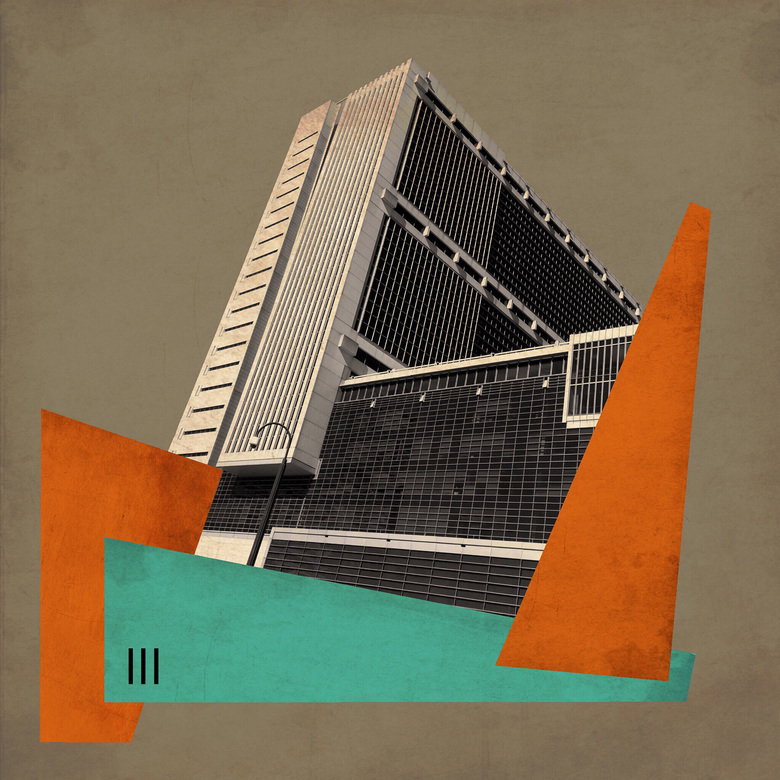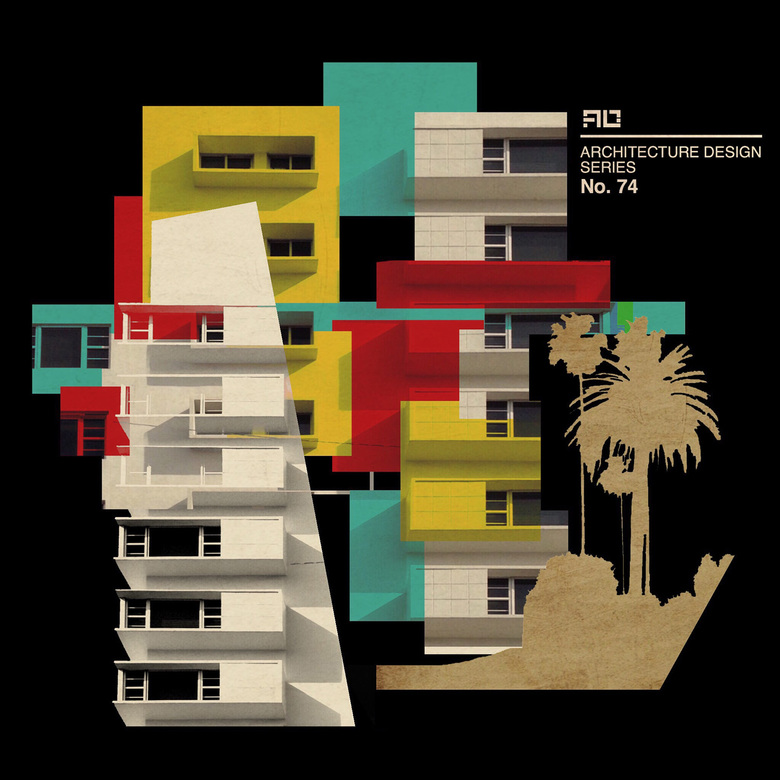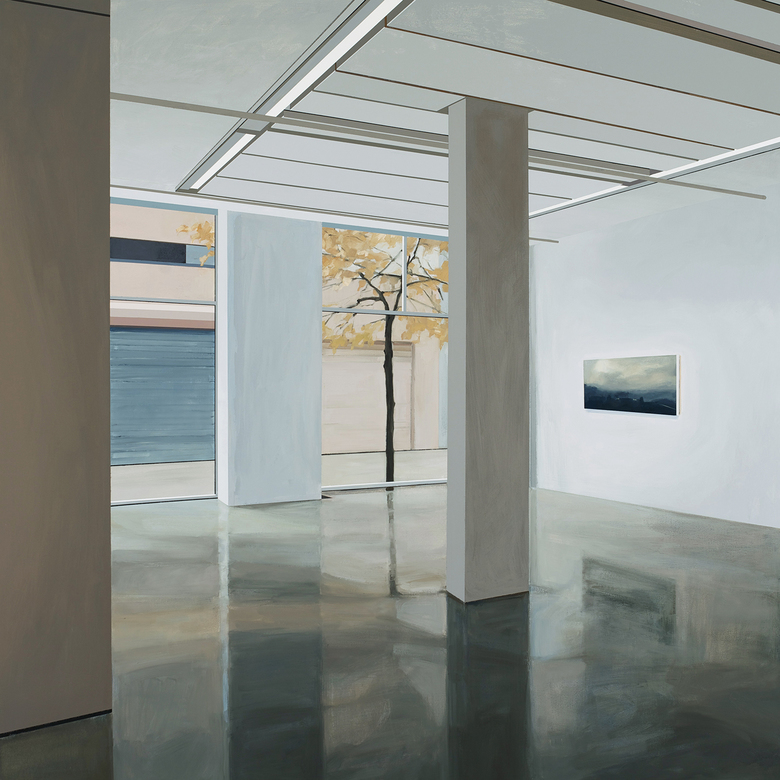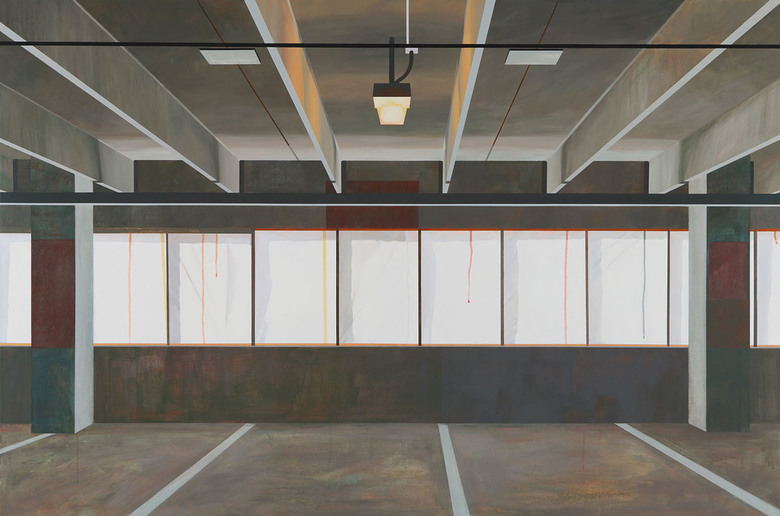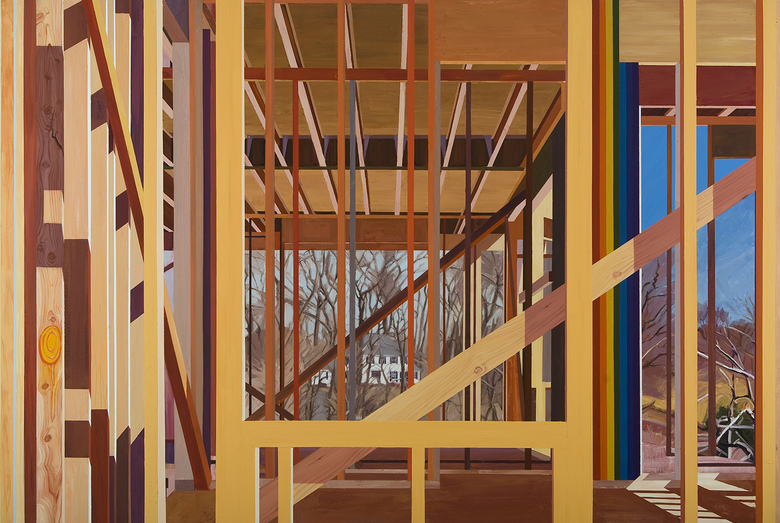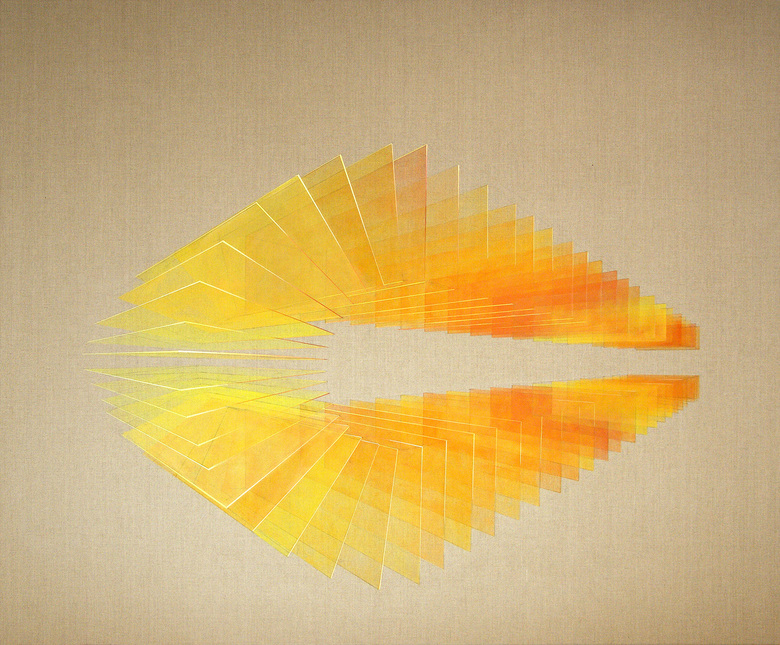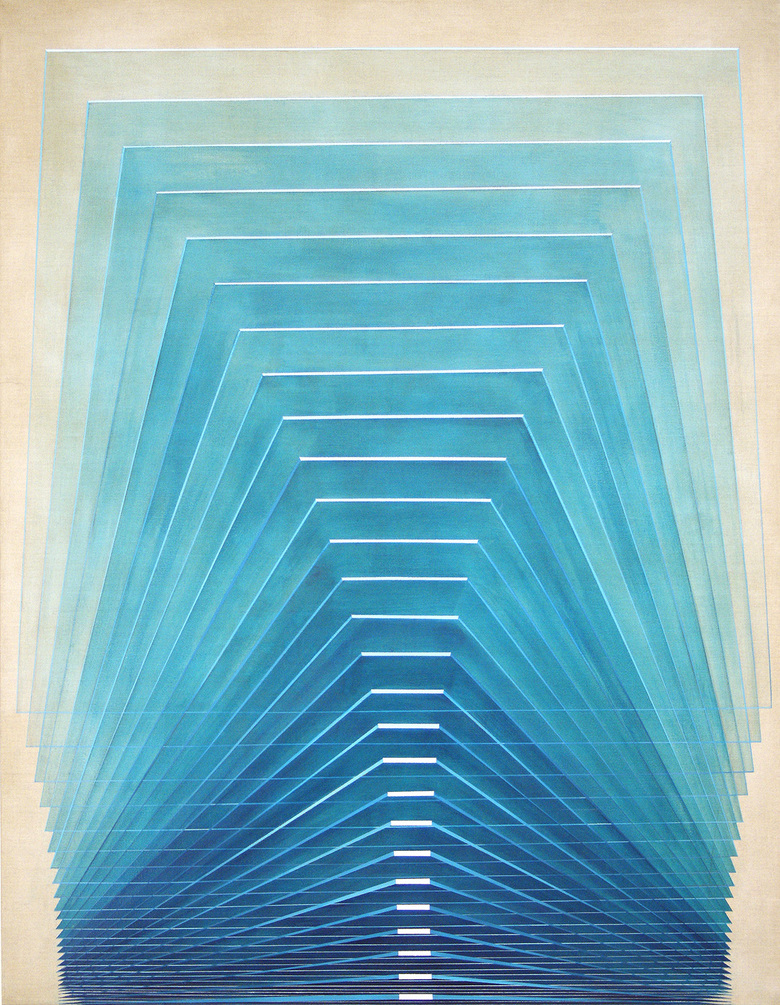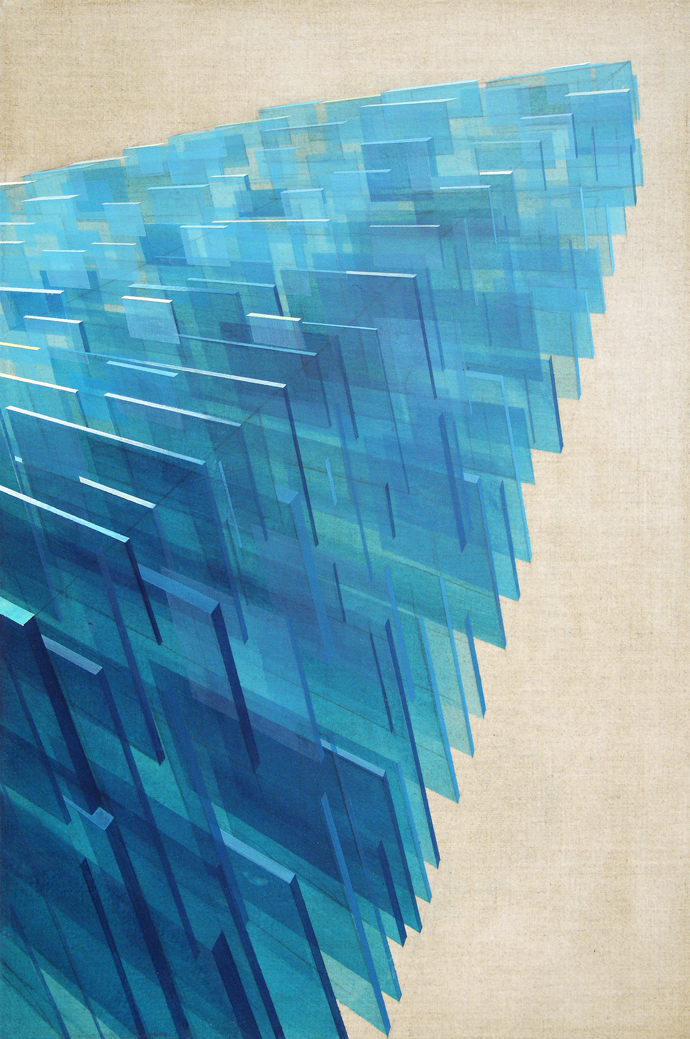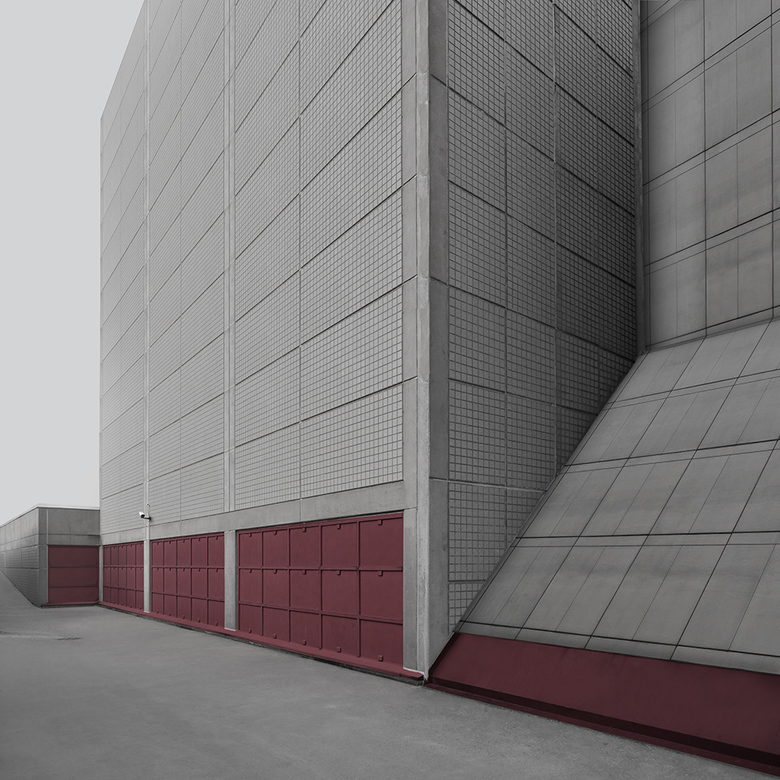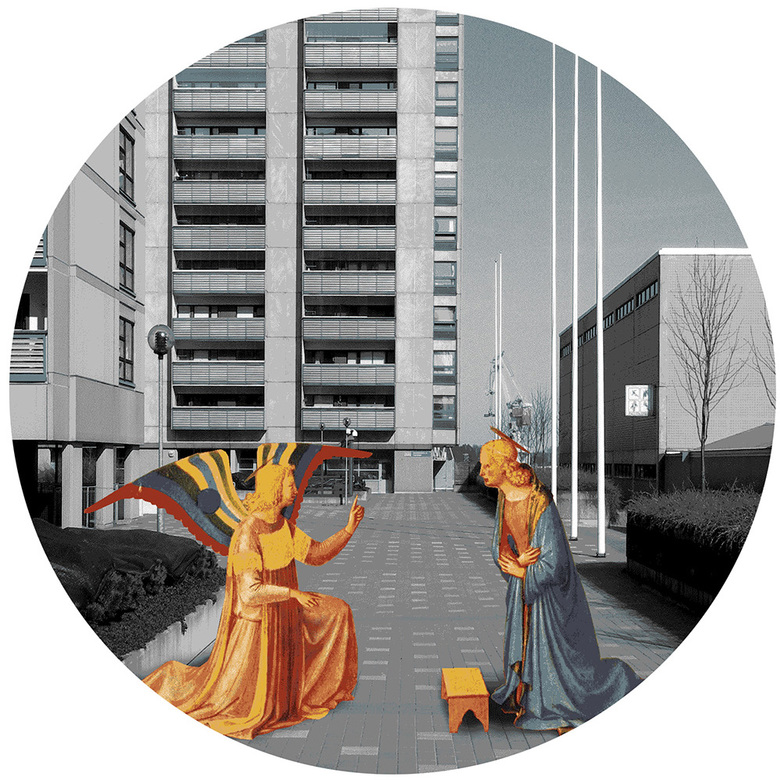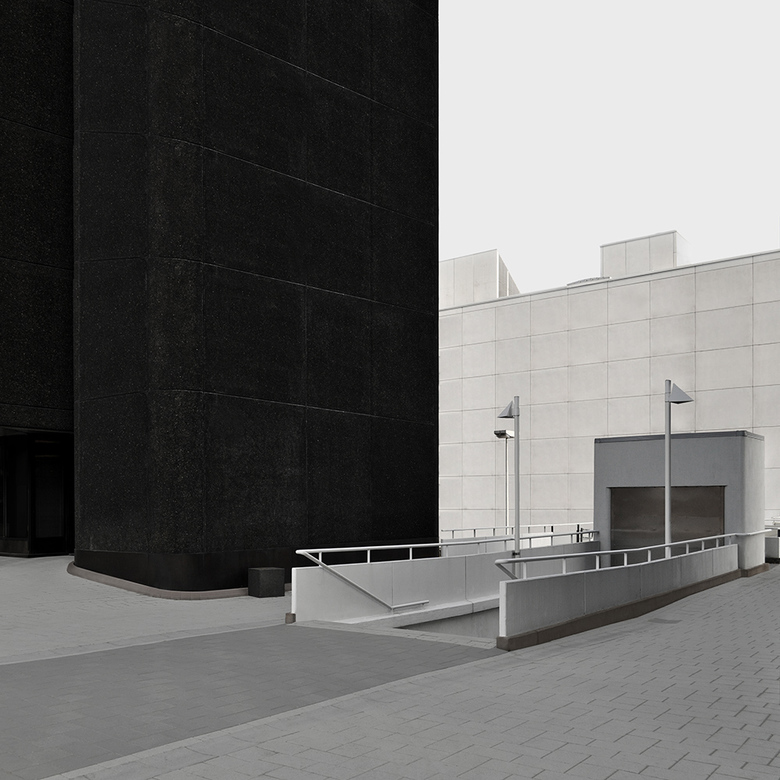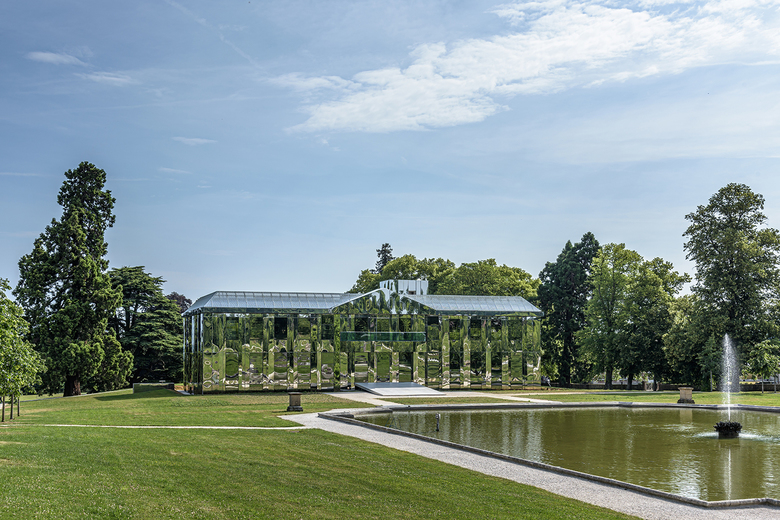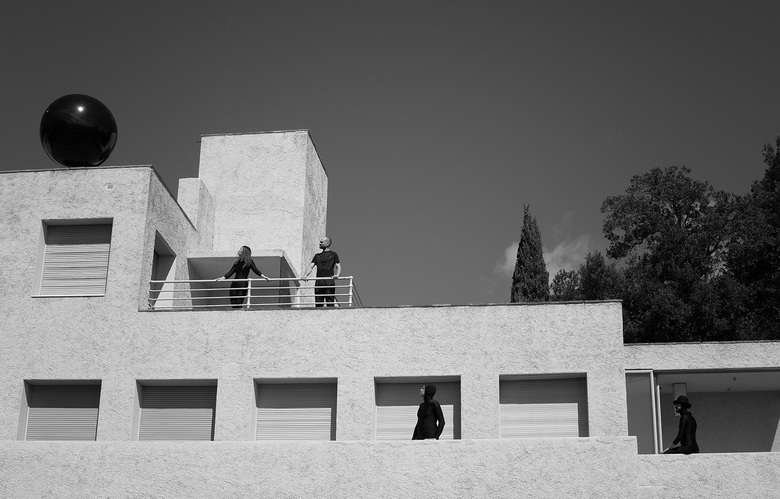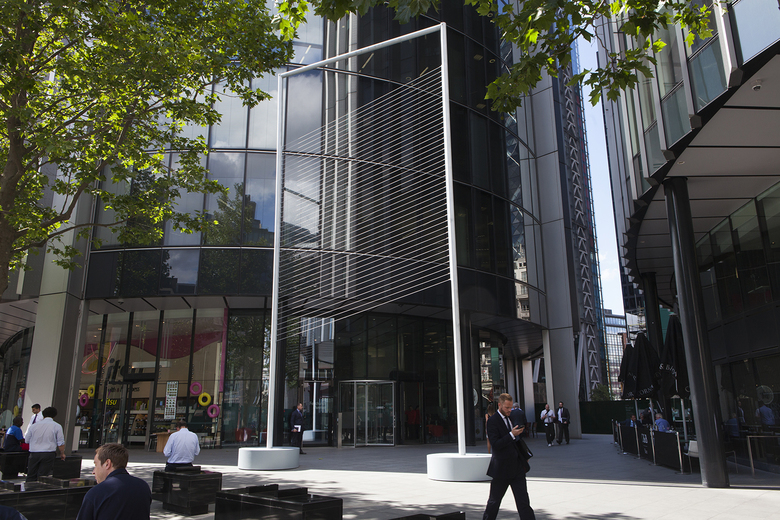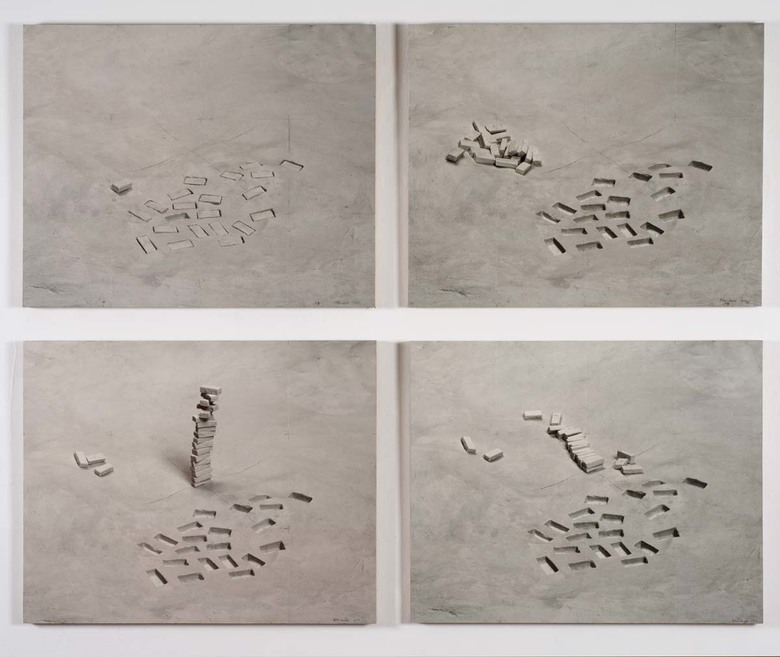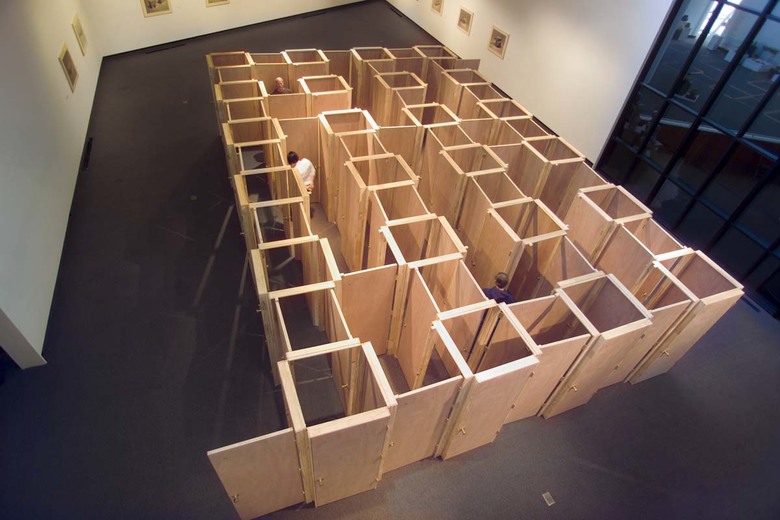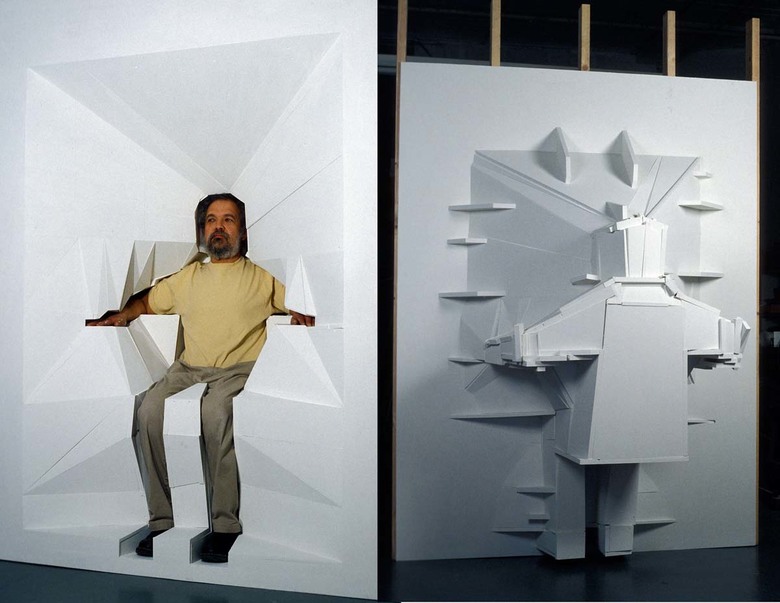Architecture as Subject for Art
John Hill
17. agosto 2015
Sarah McKenzie: Patriot, 2010, acrylic on canvas, 48 in x 72 in
At World-Architects we are big fans of art with an architectural twist, so we decided to focus on some artists who look to architecture and building as subjects for their paintings, sculptures, photographs, installations and films.
To get a sense of how artists see and think of architecture, World-Architects sent a short questionnaire to six artists: Lynette Jackson is a Georgia native whose work – much of it produced only on an iPhone – is heavily influenced by mid-20th-century architecture and design; Sarah McKenzie lives and works in Colorado where she paints buildings and landscapes in a state of flux; Daniel Mullen, born and Scotland, lives and works in Amsterdam where he creates paintings following from his passion for architecture; SerraGlia is the alias of Italian architect and visual designer Lorenzo Servi who is based in Finland and uses art as a medium to depict environments hovering between reality and fiction; Xavier Veilhan's interest in architecture spreads across multiple media, from sculpture and installations to film and "Architectones"; Allan Wexler is a New York City-based artist who has been exprimenting with architecture, design and fine art for 45 years.
Below are the artists' answers accompanied by a few examples of their work. This feature can only scratch the surface, so be sure to click on their names/links to visit their respective websites and see more of what these talented artists have produced.
Lynette Jackson
Artist's website
Why is architecture one of the subjects of your artwork?
From the moment I discovered Julius Shulman’s Stahl House images I have been interested in modern architecture. Years ago I started shooting primarily with my iPhone. I considered street photography, but quickly turned to my natural interest in architecture. My Art-Chitecture series is a creative expression of lines, shapes, colors, and architecture.
Lynette Jackson: Art-Chitecture No. 53
How do you define architecture, or what is your approach to thinking about architecture?
Architecture has several purposes, but I mostly consider architecture from an aesthetic, artistic focus. I know every inch of a completed structure has been given thought and consideration, so I look for small, simple, details of architecture. My favorite image to capture is rhythmic shadows falling across a façade. I often think, during design an architect imagined these shadows at this particular time of the day. I want to capture the moment when it occurs and present it to others.
Lynette Jackson: Art-Chitecture No. 61
What does your art have to say about, or contribute to, architecture?
I love the process of emphasizing architectural details by reimagining whole or partial structures. I create from an honest place and if I am honest during my process, then the final piece will resonate with others. When I started my Art-Chitecture series I never imagined world-wide collectors of my images. I will soon travel to shoot images for an upcoming show and commissions. I am grateful there is an audience interested in creative work which features architecture as the subject.
Lynette Jackson: Art-Chitecture No. 74
Sarah McKenzie
Artist's website
Why is architecture one of the subjects of your artwork?
To be honest, architecture has been central to my work ever since I first started painting in college. From the beginning, I was interested in looking at the structures we build and what those structures can reveal about conditions and shifts in our culture over time. In graduate school, I made paintings about abandoned houses in Detroit, Michigan, and that work really delved into the history of that city and the economic changes that the region has experienced over the past 100 years. Between 1999 and 2004, I created a series of aerial paintings that depicted suburban sprawl outside Denver, Colorado at the height of the pre-recession building boom. That series led to another five-year project, in which I zoomed in on the details and geometry of construction sites. In those paintings, produced between 2005 and 2010, the building process became a metaphor for my activity as a painter. I was interested in the connection between the construction of architecture from raw materials (lumber, steel, concrete) and the construction of a picture from raw materials (paint, canvas, wood).
Sarah McKenzie: White Walls, "Landscape 1" (Danese Corey with Dozier Bell, 2014), 2015, oil and acrylic on canvas, 48 in x 48 in
How do you define architecture, or what is your approach to thinking about architecture?
I am most interested in capturing architecture in a state of transition. Through my work, I've come to understand that all architectural structures – all aspects of our built environment – are always, by necessity, in flux. I am attracted to subjects where that condition is most apparent; hence the paintings of construction sites or abandoned, decaying buildings. Some of my more recent paintings have depicted windows in hotel rooms and parking garages – spaces that are specifically designed to accommodate the temporary and embrace change as a constant state. Along these lines, I am currently developing a new body of work that explores the architecture of exhibition space. The work is ongoing, but I have begun with images of contemporary art fair tents, minimalist gallery and museum interiors, and video-screening rooms. The spaces in these paintings are incredibly adaptive, created to house an ever-shifting array of art objects and experiences. I'm fascinated by the notion of spectacle and the role that architecture can play in orienting the viewer’s experience of a work of art.
Sarah McKenzie: Windows, "Park" (2014, oil and acrylic on canvas, 42 in x 63 in)
What does your art have to say about, or contribute to, architecture?
I think one of the reasons that many architects and designers really respond positively to my work is that it speaks to dynamics in our built environment that they already understand and consider on a daily basis. If my work contributes, it is by making these dynamics visible to an audience that does not think about architectural space in this way. Many people go about their lives, hardly considering the nature of the spaces in which they work, drive, sleep, and play. For those people, architecture becomes a sort of background, constantly impacting their experience, but invisibly. Not every viewer of my work may be able to unpack all the art-historical references and layers of meaning, but many people comment that my paintings change the way they see the world around them. I'm happy with that!
Sarah McKenzie: Constructions, "Site" (2007, oil on canvas, 48 in x 72 in)
Daniel Mullen
Artist's website
Why is architecture one of the subjects of your artwork?
I have always been fascinated by the constructed world/architecture. As a child I spent countless hours playing with LEGO, and when in physical space my imagination would transform it into my fantasies. I see architecture as a covenant to explore and stimulate the imagination through a visual language that is familiar enough to enter into yet can offer another spatial experience.
Daniel Mullen: Repetition, "Moving Repetition" (140x170cm oil on canvas) 2014
How do you define architecture, or what is your approach to thinking about architecture?
For me good architecture goes beyond a physical structure. The combination of materials, weight, light and form, are all potentials that can be greater than the sum of its parts leading to the creation of tension and mystery. It is in this mystery through which our imagination is activated, enabling us to relate, contextualize and go beyond our physical experience. The painted image can also function in a similar fashion through the subjective offering of the maker, which is neither true nor false but just a direct pure sensory experience.
Daniel Mullen: Spatial Inception, "Constructing the Horizon" (180x140cm Synthetic Polymer on canvas, 2015)
What does your art have to say about, or contribute to, architecture?
The inception of physical architecture often starts from the development of a two-dimensional visual language, like the sketches of Peter Eisenman or the paintings of Zaha Hadid. Within the canvas area my only constraint is the scope of my imagination. Through my work I want to share my vision of a universe wherein I'm the architect at play.
Daniel Mullen: Future Monuments, "Colossal Ascention" (60x40cm Synthetic Polymer on canvas, 2015)
SerraGlia
Artist's website
Why is architecture one of the subjects of your artwork?
I constantly research and analyze issues in everyday life and built environments, using them to create self-initiated projects. Because architecture is responsible for so much of the built environment around us, I often use it as a source of inspiration.
SerraGlia: Mute Spaces, “I series, #2 Merihaka” 60 x 60 cm
How do you define architecture, or what is your approach to thinking about architecture?
I see architecture as an art of communication.
SerraGlia: Contemporary Architecture In Painting, 2009, Digital C-print, Ø 70 cm
What does your art have to say about, or contribute to, architecture?
Due to inertia and habit, our eyes often passively scan the urban environment, but paradoxically, we are not really seeing. This makes the city a place of unnoticed messages. The starting point for my work involves analyzing these visual messages and suggestions by questioning how we look at and interpret them. Thus, the result of my work represents questioning rather than making statements.
SerraGlia: Mute Spaces, “I series, #4 Itä-Pasila” 60 x 60 cm
Xavier Veilhan
Artist's website
Why is architecture one of the subjects of your artwork?
For a very practical reason: the architecture is the actual limit of the exhibition. It starts where the art ends. Dealing with architecture is probably a fantasy for many artists, because it holds a certain symmetry to art that we’ve lost since the Renaissance. It’s a way for me to again merge different types of visual arts with spaces.
Château de Rentilly, 2014 (Exterior view) Philippe Bona and Elisabeth Lemercier (architects), Xavier Veilhan (artist), Alexis Bertrand (scenographer) Photo Florian Kleinefenn © Veilhan / ADAGP Paris, 2015 Commissioned work by Communauté d’agglomération de Marne et Gondoire, realized with the support of the ministère de la Culture et de la Communication, as part of the public commissions
How do you define architecture, or what is your approach to thinking about architecture?
I define architecture as the art of space, the art of engineering. I’m interested in the way things stand, the way they are built and made. I have a special taste for architecture that deals with engineering, like bridges, airports, train stations, factories and so on. I see architecture not only as a living environment, but also as an object that creates connections, generates energy or provides a certain service.
Vent Moderne, 2015 HD film, black and white, 27’39’’ Edition of 3+1 Photo Stéphane Perche © Veilhan © Mallet-Stevens / ADAGP Paris, 2015 For CINEMA EN PLEIN AIR 2015 (La Villette, Paris) – From July 22 to August 23, 2015
What does your art have to say about, or contribute to, architecture?
Usually art is something you put on top of architecture, like fruit on a cake. I am more interested in revealing the quality of the architecture through an art piece and in their synergy. I like the kind of dialogue that stems from the confrontation between the two. My work often has to deal with space and its interaction with the public, which is something it has in common with architecture. I am not very interested in architecture when it’s not activated by people. The same counts for art. One of the most exciting experiences to me is to visit not an exhibition, but an architecture, especially the one in private hands, because it allows me to project myself living in that space, which is not done as easily with art.
Rays (London), 2015 Rubber, polyester, steel, stainless steel, concrete Variable dimensions – 1200 x 600 x 150 cm (plinths : 150 x 75 cm) Courtesy of Galerie Perrotin Photo Nick Turpin © Veilhan / ADAGP Paris, 2015 For SCULPTURE IN THE CITY 2015 (London) - From July 9, 2015 to May 31, 2016
Allan Wexler
Artist's website
Why is architecture one of the subjects of your artwork?
My practice stands at the edge of architecture. I experiment with eating. A tablecloth clothes its diners. I explore bathing. A bathroom is a cistern that collects rainwater. I examine sleeping. A bed splits in two and slides through a wall. I make problems to solve problems. I look at the artifacts of normal everyday life as if they are historical artifacts. I dismantle and I misassemble. I don’t understand gravity. I allow elements to topple. I make floors float. I confuse skin with drywall. I have trouble understanding space. I squeeze four functions (four rooms) into a one-room house. I have a problem with scale. I confuse the model with reality.
Allan Wexler: Breaking Ground, "Gravity" (2013, archival digital prints, pencil, matte medium, wax 40" x 32" and 80" x 64")
How do you define architecture, or what is your approach to thinking about architecture?
I am an architect in an artist’s body. My studio is a laboratory. I sculpt with gravity and heat. I paint with rain. I use everyday and ordinary activities, eating, sleeping and bathing as media. I investigate utensils and furniture archeologically.
I practice architecture like a research scientist. I am interested in simple things; the sight line between two people sitting across from each other at a table, the many positions of two bricks in relationship to each other, how floor meets earth.
I am interested in the definition of habitable space. I explore the thickness of a wall needed to separate inside from outside. I invent ways to walk through walls.
Allan Wexler: "Open-Closed / On-Off" (2006, Southeastern Center for Contemporary Art, Winston Salem, NC)
What does your art have to say about, or contribute to, architecture?
A pulley, a lever, a wheel and dripping condensate are hardware I utilize to open a door. Low tech oscillates with high tech. My binary code is an open door and a closed door, a light on and a light off, a left path taken a path taken right. I like switches. Squeaking, creaking floorboards, the hiss of air escaping from a radiator on a cold winter morning and the slam of a screen door are material for my work.
Allan Wexler: "Wall (I Want to Become Architecture)," 2002
Email interviews conducted by John Hill.
